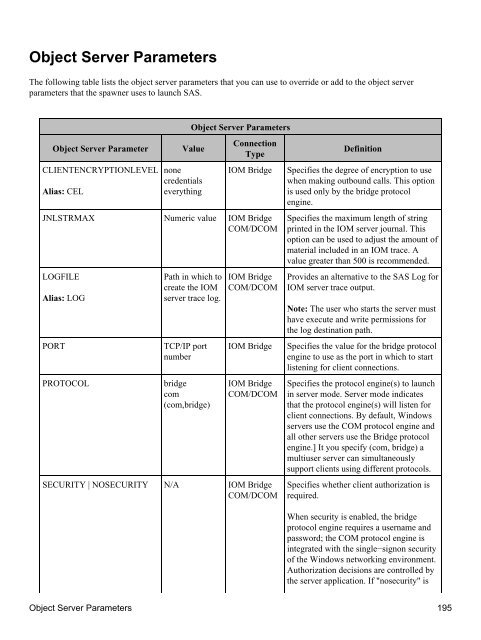SAS® Integration Technologies: Administrator's Guide (LDAP Version)
SAS® Integration Technologies: Administrator's Guide (LDAP Version)
SAS® Integration Technologies: Administrator's Guide (LDAP Version)
Create successful ePaper yourself
Turn your PDF publications into a flip-book with our unique Google optimized e-Paper software.
Object Server Parameters<br />
The following table lists the object server parameters that you can use to override or add to the object server<br />
parameters that the spawner uses to launch SAS.<br />
Object Server Parameter<br />
CLIENTENCRYPTIONLEVEL<br />
Alias: CEL<br />
Object Server Parameters<br />
Value<br />
none<br />
credentials<br />
everything<br />
Connection<br />
Type<br />
IOM Bridge<br />
JNLSTRMAX Numeric value IOM Bridge<br />
COM/DCOM<br />
LOGFILE<br />
Alias: LOG<br />
PORT<br />
PROTOCOL<br />
Path in which to<br />
create the IOM<br />
server trace log.<br />
TCP/IP port<br />
number<br />
bridge<br />
com<br />
(com,bridge)<br />
IOM Bridge<br />
COM/DCOM<br />
IOM Bridge<br />
IOM Bridge<br />
COM/DCOM<br />
SECURITY | NOSECURITY N/A IOM Bridge<br />
COM/DCOM<br />
Definition<br />
Specifies the degree of encryption to use<br />
when making outbound calls. This option<br />
is used only by the bridge protocol<br />
engine.<br />
Specifies the maximum length of string<br />
printed in the IOM server journal. This<br />
option can be used to adjust the amount of<br />
material included in an IOM trace. A<br />
value greater than 500 is recommended.<br />
Provides an alternative to the SAS Log for<br />
IOM server trace output.<br />
Note: The user who starts the server must<br />
have execute and write permissions for<br />
the log destination path.<br />
Specifies the value for the bridge protocol<br />
engine to use as the port in which to start<br />
listening for client connections.<br />
Specifies the protocol engine(s) to launch<br />
in server mode. Server mode indicates<br />
that the protocol engine(s) will listen for<br />
client connections. By default, Windows<br />
servers use the COM protocol engine and<br />
all other servers use the Bridge protocol<br />
engine.] It you specify (com, bridge) a<br />
multiuser server can simultaneously<br />
support clients using different protocols.<br />
Specifies whether client authorization is<br />
required.<br />
When security is enabled, the bridge<br />
protocol engine requires a username and<br />
password; the COM protocol engine is<br />
integrated with the single−signon security<br />
of the Windows networking environment.<br />
Authorization decisions are controlled by<br />
the server application. If "nosecurity" is<br />
Object Server Parameters 195
















